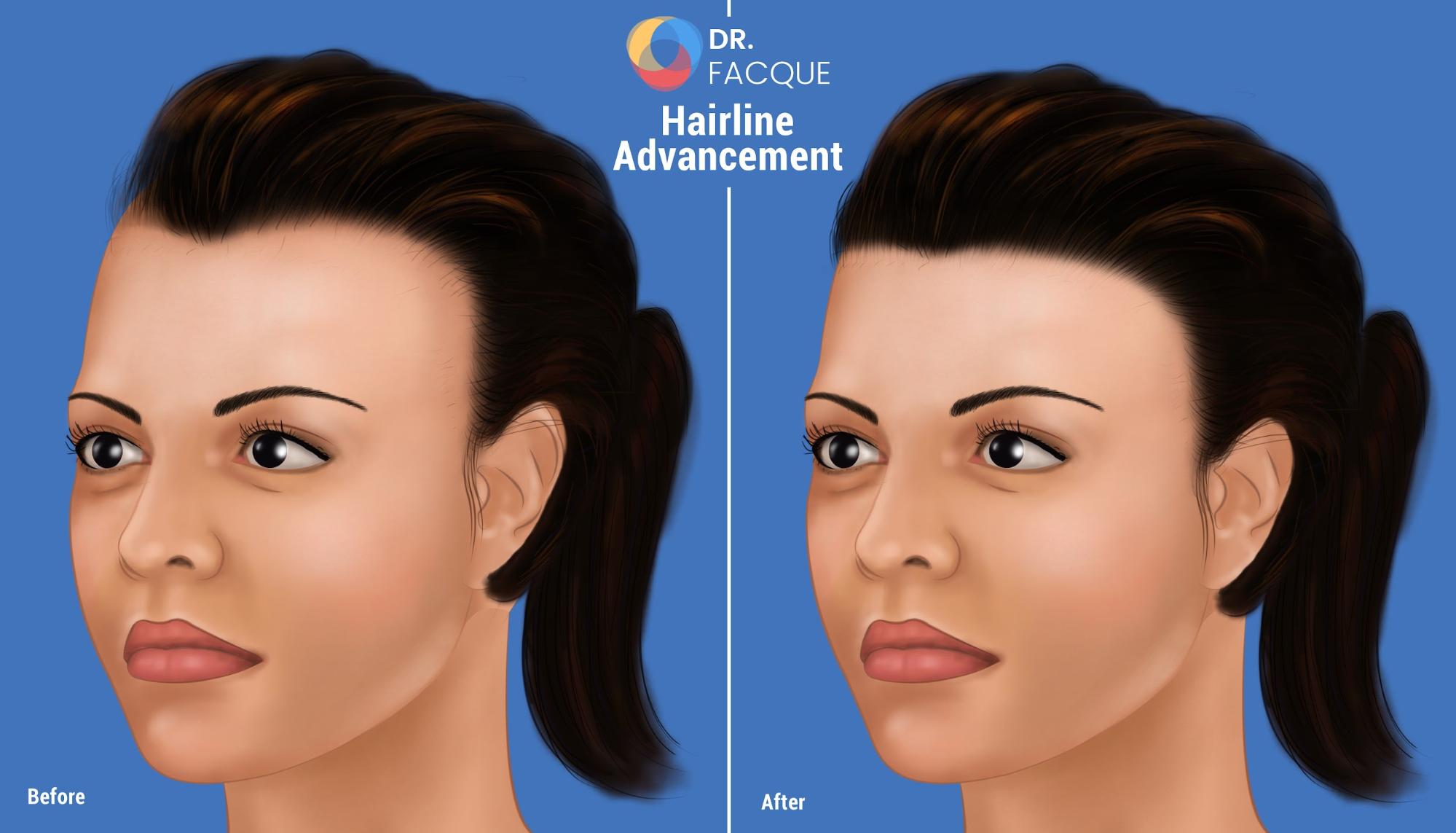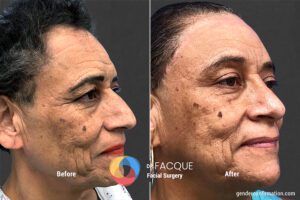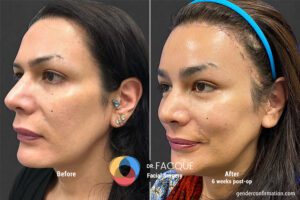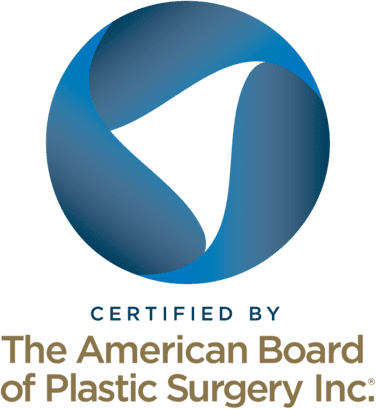FFS Hairline Lowering: Transform Your Hairline with Expert Care
Medically reviewed by Jennifer Richman on January 24, 2024.
What is FFS Hairline Lowering?
Hairline advancement surgery–also known as forehead reduction surgery, hairline lowering surgery, hairline feminization–is one of the most commonly solicited procedures in facial feminization surgery (FFS). The goal of this procedure is to reverse the effects of a receding hairline from exposure to testosterone through the creation of an incision along the hairline. Hairline reshaping is a similar procedure, often pursued by patients who have not experienced a receding hairline but still wish to round out and lower their hairline. Here we discuss candidacy, preparation for, recovery from this procedure and more.
Benefits of Hairline Lowering in FFS
Research has demonstrated that FFS generally yields high rates of patient satisfaction and many benefits, including:
- Reduced instances of anxiety and depression
- Improved body image
- Improved self-esteem
- Reduction of gender dysphoria
Anecdotally, our practice has noted that not everyone who undergoes a forehead reduction or hairline lowering surgery is satisfied with their results, even when performed by a board-certified gender surgeon. From our experience, a lot of this has to do with surgical technique. You can read about this concern in the following section:
Maximizing Patient Satisfaction: Techniques for Forehead Reduction Surgery or Hairline Feminization
To understand which techniques tend to maximize patient satisfaction, it can be helpful to think about why many trans, non-binary and gender non-conforming patients seek out a hairline lowering surgery to help them manage gender dysphoria.
Exposure to high levels of testosterone as an adult often results in hair loss, creating an “M” like shape as the corners of the hairline recede into the forehead. Many of our trans feminine patients express feelings of gender dysphoria with how testosterone has impacted their hairline. Even though people of all genders experience hair loss or balding, a receding hairline is often read as a visual cue for masculinity.
While feminizing hormone therapy that blocks testosterone can prevent the hairline from receding more, estrogen cannot reverse these effects. In other words, hormone replacement therapy (HRT) cannot grow back hair that has been lost to testosterone. For this reason, a hairline advancement or hairline lowering surgery is the only surgical option patients have to reverse a receding hairline besides hair transplants.
At the GCC (Gender Confirmation Center), our facial surgeons have seen the greatest amount of patient satisfaction with this procedure when performed a particular way. Rather than simply lowering the hairline uniformly, Dr. Facque (he/him) and Dr. Ley (she/her/they) have had more success by targeting the corners of the hairline that have receded. In other words, patients tend to not only want their hairline lowered to reduce the size of their forehead, but to have it rounded out, eliminating the “M” shape.
Candidates for Hairline Lowering
At the GCC, we adhere to the informed consent model. We recognize that transgender and non-binary people are ultimately the experts on their own experience. As a result, we believe that adults who are informed about surgical interventions can assess for themselves if they are eligible for surgery.
You may be a good candidate for hairline advancement or reshaping if you experience feelings of dysphoria with the shape of your hairline. Ultimately, only you will know if hairline lowering will bring you greater comfort with your face.
That said, many insurance providers who cover gender-affirming procedures require that patients undergo feminizing HRT for at least 6 months to obtain coverage. Exceptions can be made, for example, if there is a medical justification for not being on HRT. If you have questions about your providers requirements, you can reach out to our insurance concierge team.
Preparation for the Surgery
Before you undergo hairline lowering or reshaping, it is important to make several considerations for your safety and ensure you achieve your desired result.
Medical Clearances
Before your surgery, your medical team will reach out about what you need for medical clearance. This can mean testing, primary care visits, visits with any specialists you see for chronic medical conditions, or lab work. Hairline adjustments generally do not require medical testing, however you may need an X ray or CT scan if you pursue a simultaneous cranioplasty and frontal sinus setback. This is done so the surgeon can understand how to work around your unique bone structure. Documentation of these will need to be submitted to your surgeon to ensure your safety.
Lifestyle Adjustments
You may need to make certain lifestyle adjustments to ensure your safety and see the best results post-op. For example, patients must cease smoking at least four weeks and cease drinking at least one week before your surgery. For those who consume marijuana, we recommend that you switch to edibles or other non-smoke producing methods. You will also need to avoid Tylenol and Ibuprofen two weeks before surgery.
Certain supplements can also interact with anesthesia, and you should avoid these before surgery. Specifically for facial surgery, you should avoid dental work and coloring your hair in the week prior to FFS. Since hairline advancement will change the shape of your forehead, we ask that patients grow out their eyebrows and avoid shaping them (with makeup or any form of hair removal) so that your surgeon can position them with their natural shape as the reference point.
Mental Preparation
FFS can be an intense surgery to recover from, especially if you undergo multiple procedures at once. Patients find it vital to develop a support network to work through the ups and downs of surgery recovery: from help with the physical recovery process to emotional support as you heal. We recommend that patients connect with a mental health professional as well as community resources. You might be stressed about surgery and the toll recovery may take on you. It can be helpful to remember that this feeling of worry is separate from doubt or regret around seeking gender-affirming care.
Choosing the Right Surgeon for FFS
Choosing an experienced and board certified surgeon can give you peace of mind that your needs and goals will be met. Hospital privileges are also important, as you may stay overnight at the hospital and they will be able to directly address complications. You can get a good sense of how your results may look based off of a surgeon’s before and after gallery. Keep an eye out for if a surgeon has performed hairline procedures and if they match your goals.
Surgeons perform hairline advancements differently; some may prefer a certain incision type. Communicating with your surgeon about what brings you dysphoria about your hairline can help you decide if your surgeon can meet your goals.
The Surgical Procedure Explained
General Overview
The first step in any surgical process is requesting a consultation with a surgeon you are interested in. The consultation is an opportunity for you to discuss your goals, medical history and general goals for FFS. At the GCC, we offer free virtual and in-person consultations. If you are using insurance, you will need to begin the process of getting pre-authorization from your insurance. We also encourage you to review preoperative requirements including any medical exams you may need before surgery.
This procedure is performed under general anesthesia, meaning you will be unconscious for the whole surgery. Your surgeon will then make an incision at the hairline. From there, the scalp or forehead is altered to bring forward or pull the hairline down. Excess skin is removed and the incisions are then closed by stitches or sutures. This is a very general overview, as there are multiple techniques for hairline advancements.
Forehead Incision
A hairline or forehead incision is placed directly at the hairline. This leaves a slightly visible scar; however, creating an incision at the base of the hairline gives the surgeon more control over its final position. For example, patients can request to maintain their widow’s peak if desired. This type of incision is closed with sutures as it is along the forehead that are taken out by your surgeon or physician assistant (PA) about a week after surgery.
Recovery Process After Hairline Lowering
That said, when performed alone without concurrent facial procedures, an FFS forehead reduction procedure is one of the easiest to recover from. Once patients get past the first week of swelling and pain management, the results are visible quickly. That said, it will take up to a year for the scar to mature.
Recovery after hairline lowering looks different for everyone. Combining multiple procedures can make your recovery look different. For some patients, it can make recovery more complex. That said, procedures that are performed on the upper-third of the face generally yield faster patient satisfaction. Swelling on the forehead tends to resolve much faster than swelling in the jaw, so patients will be able to see their results quickly. To get a good understanding of what the general process looks like, we encourage you to look at our facial feminization post-op guide.
Some general recovery guidelines for this procedure are:
- Depending on the number of FFS procedures you undergo, you may need to spend a night in the hospital after surgery
- Elevating your head while you sleep and frequent icing will help manage inflammation
- You may not consume alcohol or operate a vehicle while taking prescription pain medications
- You will need to carefully follow incision and scar care protocols given to you by your care team, which may include…
- Applying antibiotic ointment to the incision site several times a day throughout the first week
- Using cotton swabs with saline solution to remove scabs that appear along the incision line
- Wearing a compression bandage
- Patients can begin washing their hair about 2 days after surgery with a gentle, neutral shampoo, but should not fully submerge their surgical site in water for the first 3 weeks after surgery
- You may return to work anywhere from 2 to 6 weeks after surgery, depending on your job activities
Risks and Considerations
Like any surgery, there are certain risks associated with facial surgery, but this should not dissuade you from undergoing FFS. Infections, scarring, sermons and hematomas are all general surgical risks to keep an eye out for. Patients who are smokers or have certain medical conditions like diabetes should speak to their surgeon about what steps they should take to reduce their risk of surgical complications.
Regardless of these risks, many patients feel that FFS is worth the difficulty of recovery and has notably improved their quality of life.
Cost of Hairline Lowering Surgery
In general procedures performed on the upper-third of the face––such as hairline feminization, a brow lift, and a brow bone reduction––can cost patients without insurance between $10,000 to $50,000. These estimates do not include anesthesia fees, facility fees or additional recovery supplies. That said, insurance coverage can drastically lower the costs of your surgery.
Insurance Eligibility
The following is a general overview. It is best to confirm your individual requirements and benefits through contacting your insurance provider. If you elect for surgery at the GCC, our insurance advocacy team will work with you to secure coverage. We have helped about 90% of our patients receive some form of coverage for their surgery.
- In order to qualify for insurance coverage for your FFS, your insurance provider will need a support letter from a mental health professional. Your insurance provider may require that this support letter contain a diagnosis of gender dysphoria.
- If the surgeon you have chosen for your FFS is out of your insurance’s network, you will also need a referral letter from your primary care physician.
- Another factor that may influence insurance coverage is estrogen HRT. Many insurance providers require that patients have received estrogen HRT for at least six months.
Financing Options
If you are unable to secure insurance coverage or still need to cover certain costs, there are several other types of financing available. The GCC partners with various different organizations to provide alternate funding, such as Care Credit which is a credit card that can pay for your initial surgery and appointments and groups that provide grants for gender affirming surgery. Many people also choose to utilize crowdfunding platforms or social media to raise money to pay for procedures.
Hairline Feminization Before and After
The following after photos were taken one week after surgery. The incision lines on each patient will have different levels of visibility. For example, as seen in the second photo, some patients may experience temporary hair loss around the incision line during the first few days post-op due to the trauma of surgery. In this case, patients can expect their hair to start growing back in the months following the initial recovery.
Personal Testimonials: Real Experiences
As previously discussed, facial feminization surgery has been life changing for many trans feminine and nonbinary people. Here we would like to share the testimonial of past patients and their personal journey with facial feminization surgery. Camille, a former patient of Dr. Facque, says the following about her FFS:
“Thanks to the entire staff of the GCC (Gender Confirmation Center) and notably Dr. Alexander Facque, every time I see myself in the mirror and pictures, I am overwhelmed with joy that I get to look like this everyday now. When I compare before and after surgery pictures, I can see the positive changes surgery has made on my face. The further I’m along in my recovery, the more the changes take effect…. Facial surgery and the recovery were some of the most physically and mentally intense things I have gone through, but I know it was the right decision to make. I am so thankful for the opportunity to unlock my fullest potential.”
FAQ
What is the expected recovery time?
It can take up to a year for you to see your final results from facial feminization surgery. You will be able to return to normal activities anywhere from two to six weeks after surgery. Hairline advancement or hairline lowering patients should follow scar-care protocols for the first year post-op while their scars mature.
What kind of scarring can I anticipate ?
This is dependent on what kind of incision is used. A hairline incision will be visible along the forehead, while a coronal incision will mostly be covered by your hair. View our scar care page to see your options on minimizing scar appearance.
Is hairline lowering reversible or adjustable?
Further procedures on your hairline are limited by the amount of skin you have. Patients may be able to undergo a revision surgery or make adjustments to their hairline with hair transplants if they would like.
Will my hairline continue to recede even after surgery?
Hairlines can continue to recede down the line due to the quantities of hormones present in the body, aging, and other health factors.
In Summary…
In the following video, Dr. Facque (he/him) gives a summary of the hairline advancement and a frontal sinus setback procedures:
Request a Free Surgical Consultation Today.
All virtual and in-person consultations with our board-certified surgeons are free. Once you fill out this form, our patient care team will reach out and guide you through every step to get to surgery.







